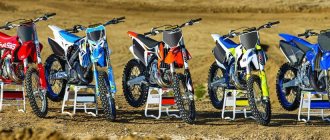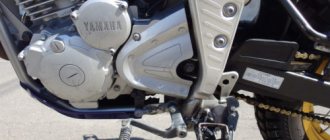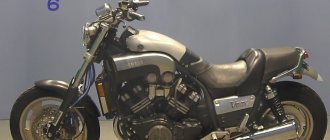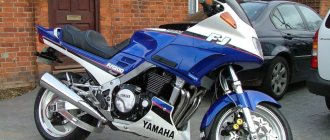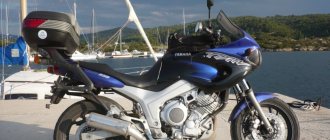This is a pleasant road bike with a measured character. He doesn't like sharp turns and other sporty maneuvers, but is perfect for quiet everyday driving. The Yamaha HZHR 1200 is good for both streets and tracks outside the city limits.
This model has not been produced for twenty years, but due to its durability and simplicity, the motorcycle can still be bought in good condition, albeit on the secondary market. He is not able to compete with the top representatives of the road class, which have recently been released, but he does not need this.
Yamaha XJR1200
Yamaha XJR1200
Yamaha XJR1200
Pomology*
The Yamaha XJR1200 replaced the FJ1100/1200 family in 1994, however, if the FJ was a “sport tourer”, the XJR was born a full-fledged “classic”. It’s clear: if back in 1984 (the year the FJ1100 debuted) an engine that produced 125 horsepower could fit into a “sport-tourist” frame, then in 1994 it was, at least, no longer competitive. However, for a moderate “classic” the engine, which by that time had already “grown” to 1200 cm3, was perfectly suited. The inline four with an air-oil cooling system turned out to be so reliable and unpretentious that in 10 years it has not lost its relevance, and the mandatory de-boosting for all classics (from 124 to 98 hp) of the already quite high-torque engine only added “juiciness” to it " The diagonal frame was replaced by a steel duplex one, only the “tail” remained of the plastic body kit, and the rectangular headlight gave way to the classic round one.
*Pomology: the science of fruits.
Where to look for worms
When choosing a “hyzher”, all standard “general motorcycle” inspections and checks are quite applicable (conditions of brake discs, approximate assessment of frame geometry violations, etc.), but there are also some features of the model that are worth paying special attention to.
XJR 1200 R 1996 (Japan)
| general information | |
| model | Yamaha XJR 1200R |
| year of issue | 1996 |
| category | classic |
| engine | |
| number of valves per cylinder | DOHC, 4 valves per cylinder |
| maximum power | 97 hp at 8000 rpm |
| bore/stroke | 77 mm x 63.8 mm |
| cooling | air |
| engine's type | 4-cylinder, 4-stroke |
| engine displacement | 1188 cc |
| compression | 9,7:1 |
| torque | 9.3 kg*m at 6000 rpm |
| transmission | |
| rear wheel drive type | chain |
| number of gears | 5 |
| wheels | |
| front tire size | 130/70-17 |
| rear tire size | 170/60-17 |
| dimensions | |
| length | 2170 mm |
| width | 765 mm |
| height | 1256 mm |
| wheelbase | 1500 mm |
| motorcycle dry weight | 233 kg |
| gas tank capacity | 21 l |
| seat height | 790 mm |
Yamaha XJR1200
sdf
sdf
The external condition of the devices sometimes does not leave the best impressions, but often the “hizhers” look worse than they actually are. After all, even the most recent copies are now more than 10 years old. However, the quality of the materials and the “monumental” design are such that neither the chrome-plated elements of the fork or exhaust system, nor the painted parts (frame or suspension elements) bear any serious traces of corrosion. True, if there is such a thing, then most likely the motorcycle has stood for many years, blown by all the salty sea winds, in the open area of some Japanese landfill, and it is better to refrain from buying such a copy - you can imagine what is going on inside the engine! Quite often, “hyzhers” suffer from oil leakage from under the valve cover. This is often the result of an aging rubber seal. By the way, traditionally for Yamaha in general and for engines with an air-oil cooling system in particular, the XJR “eats” oil. A completely normal phenomenon is a “horror” of up to 2 liters per 6,000 km of service-to-service mileage. Of course, this indicator sometimes greatly depends on both the oil and driving style. A “liquid” 10W40 synthetic engine will “eat up” much more than a “thick” 10W50 semi-synthetic. You should not use very “thick” varieties (15W50 or more): if the air temperature drops below 10 ºС, the thickened oil will create serious resistance and it is very likely that the battery will not have enough strength to turn the crankshaft. And the consequence of using “liquid” synthetics can be slippage of the starter overrunning clutch when starting the engine. This disease is treated by replacing the oil with a thicker and less “slippery” one.
Yamaha XJR1200
The rear caliper bracket sometimes collides with curbs - you need to park carefully.
The rear caliper bracket sometimes collides with curbs - you need to park carefully.
The oil level is also quite important for the XJR engine. Since the cooling system is air-oil, when the level drops to a minimum, cooling noticeably deteriorates, so it is better to keep the level at o.
A rather “talkative” timing mechanism is the norm for a “hizher”. This is the nature of an engine without a cooling jacket, so do not be alarmed by clanging sounds from the cylinder head, although someone is trying to reduce the price for a “worn out” or “unadjusted” valve drive. By the way, the statement is also true for a rattling clutch basket. The sounds will probably scare many Honda drivers, but you just have to come to terms with it. These sounds do not indicate any malfunctions or breakdowns. By the way, it is very likely that the excessively “raging” basket will noticeably calm down after washing and synchronizing the carburetors: uneven engine operation noticeably increases this characteristic clanging.
Another weak point is the clutch slave cylinder. It is located in close proximity to the drive sprocket and is not separated from it by any casing, so that all the dirt mixed with chain lube settles on its surfaces and it begins to flow. If the case is not particularly advanced, reassembling the unit and washing it will help. The best means of prevention is to coat the outside of the cylinder with a thick layer of grease, which will protect it from sand and dust, and from water. The second “ambush” is associated with attaching the clutch slave cylinder to the crankcase. Quite thin screws with fine threads are screwed into the silumin crankcase and often, due to careless assembly, the threads in the crankcase break off (CRANKER PRICE?). The force transmitted to the clutch basket by the cylinder is quite large, and if at least one of the screws is not tightened (or broken), the remaining two will suffer the same fate. So, when buying a motorcycle, you should inspect this unit more closely, check the tightness of the bolts and, if there is any suspicion, drill holes, cut new threads and install repair studs or bolts. For clearer operation of the clutch, it is worth installing a reinforced hose (PRICE?) instead of the standard one.
Yamaha XJR1200
Springs of increased rigidity are installed on the “original” shock absorbers.
Springs of increased rigidity are installed on the “original” shock absorbers.
There are no comments regarding the front brake (Brembo caliper) either in terms of efficiency or reliability. At the rear is a Tokico with a massive jet thrust. Quite often the piston warps in the cylinder and jams. So if the wear on the rear brake disc is noticeably greater than on the front ones, or it is “tarnished” in color, you should bargain with the seller for an amount equal to rebuilding the caliper with replacing all the rubber bands (PRICE?), or even the brake disc (PRICE?) , if the case is completely “clinical”. The rear brake is as effective as the front brake, so the only reasonable tuning is to install reinforced hoses (PRICE?).
Chassis and brakes
The pendants here are very simple and, accordingly, quite reliable. At the same time, both the front telescopic fork and the rear shock absorbers are comfortable and soft. Since there is a fairly powerful engine here, the brakes are appropriate. Moreover, the latter were of good quality from the very beginning of production. Three impressive discs were immediately installed on the bike, and as a result, stopping the XJR 1200 “at full speed” is not a problem.
The frame of this bike is steel and stylish. The powerful chrome-plated pipes especially stand out. You can immediately recognize this iron horse as a representative of the road classics of the eighties and nineties: literally everything speaks about this, from the headlights and steering wheel to the shape of the tank.
Yamaha XJR1200
The fastening of the clutch slave cylinder is a weak point (the repair pin with nut is highlighted in red).
The fastening of the clutch slave cylinder is a weak point (the repair pin with nut is highlighted in red).
Perhaps the last significant “bug” worthy of attention is the standard anti-theft system that was equipped with motorcycles of recent years of production. Due to imperfect design and age, in almost all cases this electronics is very “buggy” and causes a lot of trouble at the most inopportune moments. The downside is that it is impossible to disable it, since the system is “hardwired” into the engine control unit, and the only way to get rid of it is to replace the “brain” (not at all a cheap pleasure!). So it is better to opt for a copy without “anti-theft” .
White variety - black variety
The XJR1200 was not a purely domestic Japanese model; it was also supplied to Europe. Buyers have always been quite concerned about the question of the origin, or rather, the purpose of the motorcycle, because the “Japanese” speed is limited to 180 km/h. It is quite simple to distinguish the “Japanese” from the “European”: the engines of the “island” examples were always painted entirely black, while the “Europeans” shine with bare aluminum. In addition, the “domestic Japanese” were never stamped with the engine number, only the series, while all “Europeans” were numbered. Quite often you can find restored copies on sale, with engines assembled from “organs from different donors”: an engine with a light-colored crankcase and a black cylinder head, or vice versa - this should raise red flags. The rule does not apply to cylinder head covers. On absolutely all engines, both European and Japanese, it was not painted. Perhaps the most shameless deception can be considered the fairly widespread practice of selling 1200 “hugers” under the guise of the next generation of motorcycle - the XJR1300. The old model is simply “dressed up” in plastic from a more modern version and sold, “counting on a fool.” Since an inexperienced person is unlikely to be able to distinguish one from the other, it is better to be wary of suspiciously cheap 1300s and avoid them. And if you come across a “very tasty” and cheap specimen, it is better to invite one of the experienced “hyzher breeders” to the “bride.”
Selection
As we have already noticed, the engine was noticeably derated before being “registered” in the XJR frame, thanks to which it received a truly tractor-like traction throughout the entire speed range. True, the engineers have retained good potential for a completely “budgetary” motorcycle inflating. The engine is very tightly “squeezed” by the air: there is a pipe on the air filter cover onto which the filter element is placed. This pipe is almost equal in length to the filter itself and “cuts off oxygen” to the motor, cutting off most of the incoming air. The first step to “perk up” the engine is to remove this “appendix”. But it is important to leave about 2 cm from its length so that the filter element is securely fixed on it. Even this simple move will significantly add “spin” to the engine. The second step is to install a zero-resistance air filter. Even with standard jets and carburetor settings, such tuning will not lead to a lean mixture, and the dynamic characteristics will only improve. Of course, this set of “young tuners” will come in handy with a direct-flow exhaust system, but after replacing the “can,” you can’t do without installing tuning jets and reconfiguring the carbs, and this work is no longer so budget-friendly, although it is very effective.
Installing a Dynojet kit into the carburetors gives a noticeable increase in power and torque in the range from 4000 rpm and above, although with a slight decrease in “thrust” up to these rpms. The described set of works can, on average, increase engine power to 110–115 hp.
The classic road bike Yamaha XJR 1200 is an excellent transport for every day.
Powerful, unpretentious, it embodies the spirit of motorcycles from the old Japanese school of motorcycle building. Produced until the end of the 90s, it enjoyed good popularity, and continues to do so to this day, despite the fact that it received a significant upgrade at the beginning of this millennium. The new model is called the Yamaha XJR 1300, but the 1200 cc version of this motorcycle should not be discounted. This motorcycle may not shine with any stunning characteristics, but it excels in others - the balance of all its characteristics, endurance, versatility and low price. The Yamaha XJR 1200 engine is an in-line four air-oil cooled engine that produces 98 horsepower and 91 Nm of torque. The derated engine has smooth traction throughout the entire speed range, and pulls the motorcycle well from the very bottom; in addition, thanks to the low compression ratio, the XJR 1200 is not at all picky about the quality of gasoline. No, of course, it’s not worth testing a motorcycle and deliberately pouring some terrible AI-76 into it, but there is every chance that the bike will run even on it. The motorcycle accelerates from 0 to 100 km/h in more than three seconds, comparable, for example, to the Honda CB 1300.
Simple as a brick, the Yamaha XJR 1200 engine is very simple to maintain, and any motorcyclist who knows how to twist nuts in the slightest degree can do the bulk of all service operations on his own, in the garage. It is also worth noting that if a fall occurs, the Yamaha XJR 1200 engine may be damaged, so installing protective bars will not be superfluous. However, with strong inclinations, the fastening of some arches can catch the asphalt, so you should be more careful with this. The XJR 1200 five-speed transmission is an excellent example of the transmissions produced by this company. Working rather clumsily and shifting gears with a knock, the gearbox of this motorcycle, like the bike itself as a whole, is distinguished by excellent reliability. Gears shift clearly, and finding neutral is not difficult.
Despite the fact that the Yamaha XJR 1200 does not have a moderate appetite and rarely consumes less than seven liters per hundred kilometers, the volume of its gas tank, which is 21 liters, allows it to easily cover up to three hundred kilometers without refueling with a calm and not too fast ride. In addition, the fuel gauge works quite accurately, which means you don’t have to worry about being left somewhere on the side of the road with an empty tank. The dry weight of the XJR 1200 is more than 230 kilograms, not least due to the massive steel frame of the simplest type. The frame is not too rigid, which, coupled with soft suspension, turns out to be a disadvantage for fans of an aggressive riding style, since sharp maneuvers are not the Yamaha XJR 1200’s element. In addition, according to reviews from owners, there is a fairly common problem with the subframe, which sometimes breaks, so many XJR 1200 owners change this part to a reinforced one.
As mentioned above, the suspension of this motorcycle is soft and comfortable, but at the same time extremely simple. An ordinary telescopic fork and two shock absorbers at the rear - that’s all. Thanks to them, and also thanks to the wide and very comfortable standard seat, when you climb onto the Yamaha XJR 1200, you feel very comfortable. The classic arrangement of all controls contributes to a comfortable seating position. Having equipped their brainchild with a powerful motor, the designers also took care of the brakes. The tradition of installing good brakes dates back to the beginning of the production of the Yamaha XJR 400 - this 400 cc representative of the series, the smallest of all, immediately received a luxurious three-disc brake system. The XJR 1200 followed suit and, thanks to its creators, acquired excellent grippy brakes.
This motorcycle impresses with its endurance, smooth traction and impressive power, which it combines with amazing simplicity of design. Comfortable, convenient and “tailored” for a calm and relaxed riding style, the Yamaha XJR 1200 is perfect for those who prefer to ride without too aggressive maneuvers, and is suitable for everything - both for everyday riding and for traveling on a motorcycle.
Yamaha XJR1200
On domestic Japanese copies, the engine number was not stamped.
On domestic Japanese copies, the engine number was not stamped.
Repeated attempts to further increase power by removing the rev limiter were unsuccessful: all attempts to “deceive” the electronics only led to a drop in power, so we do not recommend experimenting with this. The only way out is to install Power Commander. But removing the “Japanese” speed limiter is quite simple: just disassemble the device and disconnect the wire - the only one coming out of the speedometer. True, in this case the maximum speed will not increase much - to about 195 km/h, then the speed cut-off is triggered, so there is no particular practical sense in this modification.
Trust as an element of the system
Yamaha's principled approach, implemented in the A-S1200 integrated circuit, inspires respect and trust. They could have done like many others - left the XLR connectors “for beauty” and quietly abandoned the proprietary concept of a balanced path, used more cheap op-amps, even reduced power and increased distortion... No, they retained the high class, everything that affects on the character of the sound, and reduced only minor things that may not be needed at all.
This is how user loyalty is won. And it is more important than short-term gain.
Prepared based on materials from the AudioVideo Salon portal, October 2021
www.salonav.com This review was read 6,512 times
Yamaha XJR1200
We control the oil level through the inspection window on the right side of the crankcase.
We control the oil level through the inspection window on the right side of the crankcase.
Another very useful and not very burdensome procedure designed to improve the consumer properties of the device is replacing the standard “525” chain and sprockets with “530”. The higher cost of the reinforced kit will more than pay for itself with a significantly longer service life.
Yamaha XJR1200
Cut pipe of the air filter cover (the original length of the part is indicated).
Cut pipe of the air filter cover (the original length of the part is indicated).
It is also worth paying attention to the rear tire. At the factory, the motorcycle was equipped with 180/55ZR17 tires. If you install a little wider tires - 190/55ZR17, the stability of the device at speed will improve slightly. But there is no point in experimenting with wider “rollers”: “stability” will turn into “sluggishness”.
How much for two hundred kilos?
Unfortunately, in Russia the motorcycle has not gained the popularity it deserves. There are noticeably fewer “hizhers” on sale, both in motorcycle dealerships and among private owners, than, say, a Honda CB1000. Apparently, this is due to the lower cost. On average, the price range ranges from 90–100 thousand rubles. for devices from 94–95 years, up to 150–170 thousand rubles. for copies of recent years of production. Don't be surprised to see a motorcycle in an ad with a bikini half-fairing and a rectangular headlight. This is not a home-grown tuning, but a version produced in small quantities. By the way, the small fairing does its job very well. Also, don’t be surprised to see the year 1997 in the ad. 2 years???THE YEAR 2000 after the end of production of the “1200” model, Yamaha released a kind of “anniversary” series of the XJR1200SP. The EsPe differs from the usual “hyzher” in its coloring and some details, but otherwise the motorcycle is identical to the basic version, but due to the more recent year of manufacture it costs 10–20 percent more.
Dimensions and weight
You can't call the XJR 1200 a lightweight car. Even without fuel, its weight is 232 kg. The fuel tank is impressive in its size - there are not many road bikes that have a capacity of up to 21 liters. But it is important to remember that gasoline consumption per 100 km here can range from 6 liters to 10 liters, and to save money you should not drive too fast. In general, the car has average dimensions and will be comfortable for a person of average height.
Yamaha XJR1200
The frame number is traditionally stamped on the steering column.
The frame number is traditionally stamped on the steering column.
As for selling the device after a few seasons, as a rule, there are no problems. Although the motorcycle is not as popular as others, there is always a stable demand for it. XJR doesn't lose much value as it ages. The guarantee of this is the more than once mentioned reliability and unpretentiousness of the machine. And, besides, everyone knows that true classics do not age, which means they do not lose value.
The author thanks Pavel Orlov from Moscow for technical advice and the motorcycle provided for filming.



